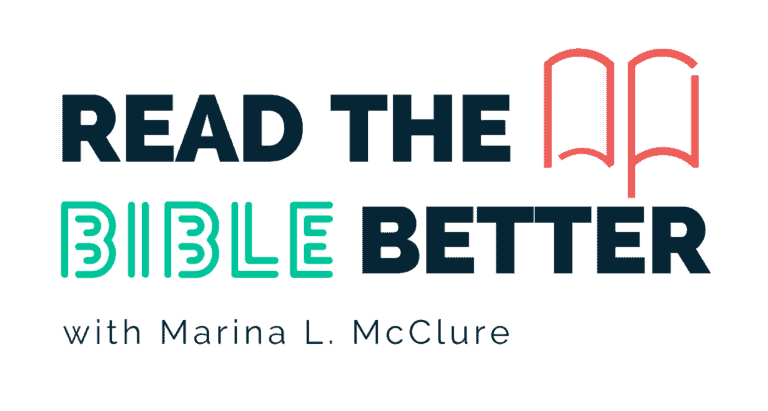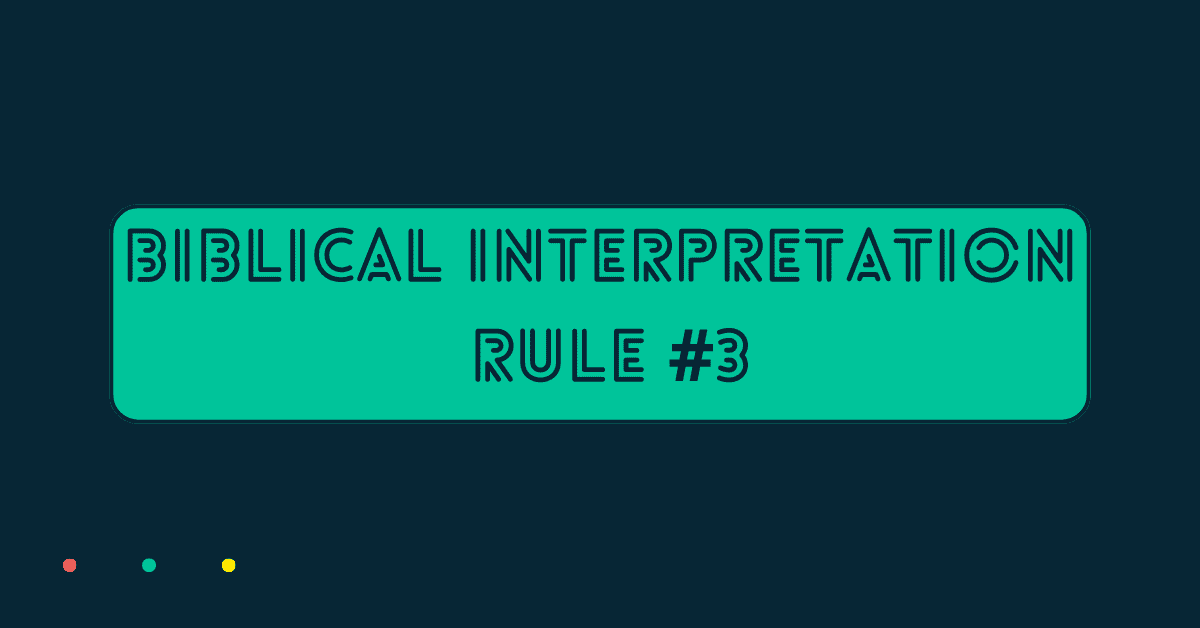Author’s note: These rules come directly from Dr. Lynn Cohick, a scholar, professor, and academic dean at Northern Seminary. While we’re using Dr. Cohick’s phrasing and organization, the underlying principles are widely used and accepted. That said, the explanations of them are mine – so please blame me for things that remain unclear.
The third and final rule for Biblical interpretation is “Pay Attention to the Text and Note Our Own Expectations and Biases.” (The first, as a reminder, is “Distinguish between prescriptive v. descriptive statements. And the second is “Recognize Social Location.”)
This third rule, which you might successfully argue could really be divided into at least two rules, encompasses a lot. But, fear not, we’re going to go through the pieces individually.
First, “pay attention to the text.” This may seem like a no-brainer, but there are certainly times when I’ve thought I knew exactly what the Bible had to say about a certain topic, but when I’ve revisited the text, I’ve found that I either missed (or added) some details or ideas. Truly, this is so very easy to do.
This principle is also important to consider when we’ve got the text right in front of our faces. I’m almost certain that most people who read the Bible with regularity have come across a phrase, an idea, or a detail in a verse that they’ve read “a hundred times,” but now are seeing for the first time. I don’t really know how this happens but it does. It certainly happens to me.
It may sound silly, but one practice I recommend is reading out loud. What we really need to do is to slow down, and somehow reading out loud forces us to slow our comprehension down in a way that helps us to catch a lot. Way back in my college days, I used to edit other people’s papers for a little money on the side. One of the few rules I had was that anyone who wanted me to edit had to first read their own paper out loud. It’s amazing how many little things will pop out at us when we’re reading out loud. Again, the why behind this is a mystery to me, but I promise it works.
Paying attention can mean more than just ensuring that we actually see and digest each word involved in the text we’re examining. We also want to slow down and really consider or ponder (or, as the Bible often urges us to do “meditate on”) what we’ve read.
If it’s a section that describes a person or event, it can be incredibly helpful to try to picture the scene as it unfolds. One of my favorite examples to use with this idea is the story of the man being lowered through the roof to Jesus as his friends help him seek healing.
Here’s the version of this story from Mark:
Mark 2:2-12 (NIV)
2 They gathered in such large numbers that there was no room left, not even outside the door, and he preached the word to them.
3 Some men came, bringing to him a paralyzed man, carried by four of them.
4 Since they could not get him to Jesus because of the crowd, they made an opening in the roof above Jesus by digging through it and then lowered the mat the man was lying on.
5 When Jesus saw their faith, he said to the paralyzed man, “Son, your sins are forgiven.”
6 Now some teachers of the law were sitting there, thinking to themselves,
7 “Why does this fellow talk like that? He’s blaspheming! Who can forgive sins but God alone?”
8 Immediately Jesus knew in his spirit that this was what they were thinking in their hearts, and he said to them, “Why are you thinking these things?
9 Which is easier: to say to this paralyzed man, ‘Your sins are forgiven,’ or to say, ‘Get up, take your mat and walk’?
10 But I want you to know that the Son of Man has authority on earth to forgive sins.” So he said to the man,
11 “I tell you, get up, take your mat and go home.”
12 He got up, took his mat and walked out in full view of them all. This amazed everyone and they praised God, saying, “We have never seen anything like this!”
Let’s take note of a few details easily glossed over. These amazing friends are trying to squeeze in to see Jesus as he’s surrounded by a bunch of people inside some building. (We can deduce that he’s in a building by the noted presence of a roof.) These friends climb up on the roof, somehow bringing along their paralyzed friend without killing him or any of themselves in the process. Just picture what that might have looked like for a minute. Impressed? I am.
Next, the text tells us that the friends “made an opening in the roof…by digging through it.” Hold up! The friends DUG THROUGH THE ROOF. Y’all. Let’s just be practical as we pay attention to the text. How long do you think it might take to dig through a roof? This roof, no matter what it was made of, was substantial enough to function as a roof, so we’re safe to assume it wasn’t made of a single layer of Kleenex. Right? So, without any research into ancient architectural practices, we can come to understand that this process probably took a little bit of time, not to mention effort.
Here are a few thoughts to consider: Was there dirt or other material falling down near (or on!) Jesus while they were digging? Did he notice? Did he stop? Did the crowd notice? Or was everyone shocked when light suddenly started coming through the roof?
And what about the person who owned said roof? It’s reasonable to assume that they were present. I don’t know about you, but I don’t think I could be so entranced by any sermon as to have zero feelings of concern when I saw my roof had been busted through by unknown persons for reasons that, at least momentarily, would not have been clear.
I can’t read this story without thinking about myself standing in the crowd, completely distracted by falling bits of clay and mud, only to finally have my curiosity further piqued by a hand or arm or tool making it’s first complete hole in the roof. In my imagination, I may have completely stopped listening to Jesus. I also would probably be looking over at whomever owned this building, checking for signs of their response to this new “maintenance issue.”
If you’re wondering what the heck this fascinating journey into our imaginations has to do with proper Biblical interpretation, I’m so glad you’re wondering.
One answer is that having a more fully formed picture of this moment not only opens you up to more nuanced understanding (and, eventually, interpretation) of the events described, but it also helps inoculate you against an incongruent interpretation that you may have tossed your way in the future.
Notice the end of this passage; though Jesus gets some flak from some of the curmudgeonly teachers in the crowd, it also tells us that the man got up and “walked out in full view of them all.” What we can notice here is that, regardless of the reaction of some of the critics in the crowd, something shifted in the moment that allowed this man to pick up his mat and walk out… though a room that we’ve already been told was so full that the friends who were obviously willing to put in a little hard work couldn’t even wedge themselves into it. That’s why they ended up on the roof in the first place, right?
I’m not going to take up space here imagining hypothetical faulty interpretations about this story, but I hope I’ve persuaded you that having the text digested within our minds and imaginations in a more fully “attentive” way not only equips us to see it more comprehensively, but also gives us what we need to spot potential pitfalls in other interpretations that may come our way.
Let’s move onto the next part of Cohick’s rule: “Note our expectations and biases.” I love the way she phrased this. She doesn’t say “ignore our expectations and biases” or “discredit” them. She says to note them, and I find this to be very wise phrasing.
We all have expectations and biases. Biases might easily be considered “bad” on their face, and in some contexts that may be true. In others, perhaps not. We’re not looking to make a value judgment here. This principle is about neutralizing what we might unconsciously bring to the table so that we can be open to maturing, improving, and elevating the way we engage with and receive the Bible and its interpretation.
As we consider this idea, let’s talk about Romans 16:7.
This verse, from Paul’s letter to the church at Rome reads, “Greet Andronicus and Junia, my relatives who were in prison with me; they are among the apostles, and they were in Christ before I was.” (NRSV)
Andronicus and Junia are most likely husband and wife. This conclusion may seem obvious, but it is also supported by many other such references from the same time period, both Biblical and those outside the Bible, that are constructed in the same way.
For almost 1300 years, readers and students of the Bible did as the ancient church fathers did, and understood Andronicus and Junia to be a married couple – male and female.
However, more than a millenium after the writing of Romans, a Medieval theologian, Giles of Rome, held a strong bias that a woman could not hold the title of “apostle” as Junia is noted to do in Romans 16:7. Based on this pre-conceived idea, he concluded that an error must have been made – and he created a man’s name, Junias to “resolve” the evidence of the ancient text that was contrary to his own expectations.
It is worth noting that the name Junia is a very common ancient Roman name that occurs over 250 times in Roman inscriptions alone. Like many names in ancient Rome, it also has a known male equivalent, Junius, which is also found repeatedly in ancient sources.
Junias, on the other hand, has never been found in any Greco-Roman manuscript, inscription, or contextual evidence. Ever.
Be that as it may, Giles of Rome held positions of authority and influence within the church, and began to propagate his “correction” of Junias in his own lifetime.
In 1522, Martin Luther’s incredibly influential translation of the Bible into German was published, containing the names of two men in Romans 16:7: Andronicus and Junias.
I will spare you the tedium of tracking each development of the text’s translations over the last 800 years. But I will say that as the scientific art of translation has matured, aided by many discoveries and advancements in Biblical archaeology and other related fields of study, there are only a very small number of modern-day translations that perpetuate the use of the name Junias.
Many – even those used in churches that disavow women in leadership roles – have reverted back to the original form of the text, originally used and embraced for generations without issue. In the interest of full-disclosure, I will add that there are now ongoing differences in the way that some interpreters (and translators) have decided to understand the term “apostle” as it is used here in Romans 16:7, and yes, many of these discussions center on the usage of the term “apostle” in relationship to Junia, now that she’s widely accepted to be a woman.*
I’m not going to expand a lot more on this idea of biases and expectations. I hope its applicability in the context of interpretation is quite clear at this point. (And if it’s not, I’m sorry. Please don’t hesitate to send me a message and I’d be glad to try to clarify.)
The summary is this: we have to be aware of and take note of the places we do (or might) hold biases and expectations about what we are reading and how to understand it. If we don’t do so, we may be motivated to edit the Bible in a way that isn’t authentic. Even if our intentions are sincere, the story of Junia shows that even a single “s” can change and challenge the understanding of one of Paul’s admired and close friends for hundreds of years.
And nobody wants that.
/
*If you have interest in understanding the Junia discussion more fully, or in understanding the religious and cultural conditions that allowed Giles of Rome to come to his conclusion about Junia’s fitness to be an apostle, I strongly encourage you read “The Making of Biblical Womanhood” by Beth Allison Barr. Barr is an historian and professor by trade, but also happens to have been a pastor’s wife for many years.
She wrote this book when the conflict between what she knew of proven history and what she was taught about the roles of women in her church finally came into sharp enough conflict to convince her to do so. Her book is utterly scholarly in its soundness and research, but it’s shared as part of her relatable, accessible, and inspiring personal story. I cannot recommend it enough.





